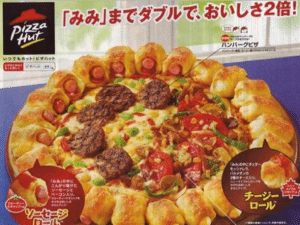 For all those people in the world who cannot get enough of the color black, Burger King Japan has your burger. As off-putting as it may sound, the Kuro (translates to black) burger is making a comeback due to popular demand. The gothic burger is available in two delectably dark varieties: diamond and pearl. The burgers come complete with bamboo charcoal-dyed black buns and black cheese, and are topped off with a black squid-ink sauce.
For all those people in the world who cannot get enough of the color black, Burger King Japan has your burger. As off-putting as it may sound, the Kuro (translates to black) burger is making a comeback due to popular demand. The gothic burger is available in two delectably dark varieties: diamond and pearl. The burgers come complete with bamboo charcoal-dyed black buns and black cheese, and are topped off with a black squid-ink sauce.
It all began in 2012, when the bacon-covered Kuro Ninja burger was introduced to Burger King’s Japanese Market. The limited-time burger saw great success, despite a human’s natural tendency to avoid eating foods that look like they have been to hell and back. However, if a weird-looking food is going to make it anywhere, it’s going to make it in Japan. The contemporary Japanese consumer embraces the bizarre and avant-garde, and it seems like the stranger the food, the more popular it will become.

Japan has had a history of outlandish fast food offerings from some of the biggest fast food brands. Wendy’s introduced a $16 Foie Gras Burger featuring a standard hamburger patty topped off with a not-so-healthy dose of fatty duck liver. Burger King offered a massive NY Pizza Burger complete with a beef patty topped with pepperoni, mozzarella, and tomato sauce, all sandwiched between a 9.5” bun. Not to be out done, Pizza Hut introduced its Bacon Wrapped Sausage Crust Mini Hamburger Pizza, and the name says it all. The list of odd food offerings is vast, but you probably get the idea by now.
In the case of the mostly-black Kuro burger, the consumer is going against their human nature to avoid foods that don’t look appealing. We have all heard the phrase, “You eat with your eyes first,” so how is it that a black burger can sell like hotcakes in Japan? In a traditional setting, color strongly affects the way a consumer perceives food and how it tastes. From birth, humans develop certain taste expectations based on the color of the food. For example, you would expect a yellow pudding to taste like lemon or banana. On the same note, you would expect a black burger to taste like ash.
The processed food we consume in America is, more often than not, color enhanced to increase appeal. Color is used to imply a certain taste or present a certain level of quality. When you go to the store to buy apples, do you not look for the brightest, most color saturated fruit? Most consumers do. Color plays such a huge role in our taste perception, when in the absence of color direction, consumers have had a difficult time discerning a particular flavor that they are very familiar with.
Since Japanese consumers are still attracted to a burger that someone would never eat if it were presented to them out of context, implies that consumers are attracted to the burger for the novelty. No one sees the Kuro burger and thinks, “Hm, that looks delicious, I must eat it!” Consumers are more likely thinking, “Oh, that is different, I need to try it!” These two varying pre-purchase thought patterns require significantly different marketing tactics in order to get consumers to try the product. Because the Burger King Kuro burger is a novelty, it needs to be presented as such, ergo the over-abundance of black ingredients. Burger King understands their product’s position, and they went full-force into the land of novelty fast food.








